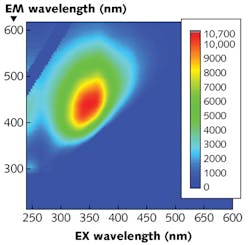A-TEEM combines absorbance, transmittance, and fluorescence spectroscopy
All molecules exhibit unique molecular absorbance and transmittance spectra, and many also have unique fluorescence excitation and emission spectra that can be rendered as two-dimensional excitation-emission matrices (EEMs). For example, EM (emission) and EX (excitation) wavelengths can be plotted for dissolved organic matter in water, revealing spectral details of the mixture. Using a thermoelectrically cooled CCD fluorescence detector for rapid fluorescence-data acquisition and a double-grating excitation monochromator for stray-light rejection (<1%), the Horiba Scientific (Kyoto, Japan) A-TEEM hardware packaged with the Aqualog spectrometer system automatically corrects for inner filter effects (IFEs). These IFEs distort fluorescence spectra as sample concentrations increase because of the reabsorption of fluorescence in the region of spectral overlap with the absorption spectrum. Simultaneously measuring the absorption spectrum and EEM, A-TEEM corrects for absorbance of all the emission to reestablish the linear relationship between concentration and fluorescence intensity, thus reducing the need for dilution and allowing collection of precise spectral library components that are independent of concentration over a wide range.
A-TEEM fingerprints molecules with simultaneous absorbance, transmission, and IFE-corrected fluorescence at a rate of 6 million nm/minute, producing results in seconds. With excitation in the 200–800 nm region with photometric accuracy of ± 0.01 AU (absorbance units) and repeatability of ± 0.0002, A-TEEM identifies and quantifies single molecules and mixtures, protein conformation and aggregation changes, product adulteration, and the effects of aging, oxidation, and contamination. The instrument is suited to water-quality research and monitoring, wine-constituent analysis, protein purity, and vaccine quality-assurance applications. Reference: https://goo.gl/RjLsVH.

Gail Overton | Senior Editor (2004-2020)
Gail has more than 30 years of engineering, marketing, product management, and editorial experience in the photonics and optical communications industry. Before joining the staff at Laser Focus World in 2004, she held many product management and product marketing roles in the fiber-optics industry, most notably at Hughes (El Segundo, CA), GTE Labs (Waltham, MA), Corning (Corning, NY), Photon Kinetics (Beaverton, OR), and Newport Corporation (Irvine, CA). During her marketing career, Gail published articles in WDM Solutions and Sensors magazine and traveled internationally to conduct product and sales training. Gail received her BS degree in physics, with an emphasis in optics, from San Diego State University in San Diego, CA in May 1986.
